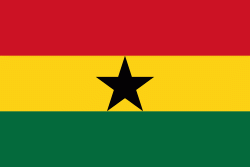Kumasi Metropolitan Assembly (Earth)
Kumasi Metropolitan Assembly (abbreviated as the KMA) is one of the 260 Metropolitan, Municipal and District Assemblies (MMDAs) in Ghana and forms part of the forty-three districts in Ashanti Region, Ghana with Kumasi being its administrative capital. The metropolis is located in the central part of Ashanti Region and has Kumasi (the regional capital) as its capital city.
The city of Kumasi was founded by King Osei Tutu I in the 1680s to serve as the capital of the Asante State. Due to the location of Kumasi and its dominance in the politics of the Gold coast in the early days, Kumasi evolved into a major commercial hub with all the major trading routes across the country converging within it. Unfortunately due to the colonial rule Kumasi also came under the British rule in 1890. Kumasi grew with time and eventually evolved to become the second largest city in terms of land area, population size, economic activity and socio-economic lifestyle to Accra the largest in Ghana.
Originally founded in 1680, "Kumasi" later then became known became known as the Kumasi City Council from 1988 until 1995, when it was upgraded into metropolitan assembly status. Evolving around the three communities of Adum, Krobo and Bompata, Kumasi has eventually grown in a concentric form to cover an area of approximately ten (10) kilometers in radius. The direction of growth was originally and initially along the arterial roads due to the accessibility and permeability they offered resulting in a radial pattern of development.
The city of Kumasi was founded by King Osei Tutu I in the 1680s to serve as the capital of the Asante State. Due to the location of Kumasi and its dominance in the politics of the Gold coast in the early days, Kumasi evolved into a major commercial hub with all the major trading routes across the country converging within it. Unfortunately due to the colonial rule Kumasi also came under the British rule in 1890. Kumasi grew with time and eventually evolved to become the second largest city in terms of land area, population size, economic activity and socio-economic lifestyle to Accra the largest in Ghana.
Originally founded in 1680, "Kumasi" later then became known became known as the Kumasi City Council from 1988 until 1995, when it was upgraded into metropolitan assembly status. Evolving around the three communities of Adum, Krobo and Bompata, Kumasi has eventually grown in a concentric form to cover an area of approximately ten (10) kilometers in radius. The direction of growth was originally and initially along the arterial roads due to the accessibility and permeability they offered resulting in a radial pattern of development.
Map - Kumasi Metropolitan Assembly (Earth)
Map
Country - Ghana
 |
 |
| Flag of Ghana | |
The Bono state existed in the area that is modern day Ghana during the 11th century. Kingdoms and empires such as Kingdom of Dagbon in the north and the Ashanti Empire in the south emerged over the centuries. Beginning in the 15th century, the Portuguese Empire, followed by other European powers, contested the area for trading rights, until the British ultimately established control of the coast by the 19th century. Following over a century of colonial resistance, the current borders of the country took shape, encompassing 4 separate British colonial territories: Gold Coast, Ashanti, the Northern Territories, and British Togoland. These were unified as an independent dominion within the Commonwealth of Nations. On 6th March 1957, Ghana became the first country in Sub-Saharan Africa to achieve sovereignty. Ghana subsequently became influential in decolonisation efforts and the Pan-African movement.
Currency / Language
| ISO | Currency | Symbol | Significant figures |
|---|---|---|---|
| GHS | Ghanaian cedi | ₵ | 2 |
| ISO | Language |
|---|---|
| AK | Akan language |
| EN | English language |
| EE | Ewe language |
| TW | Twi |















